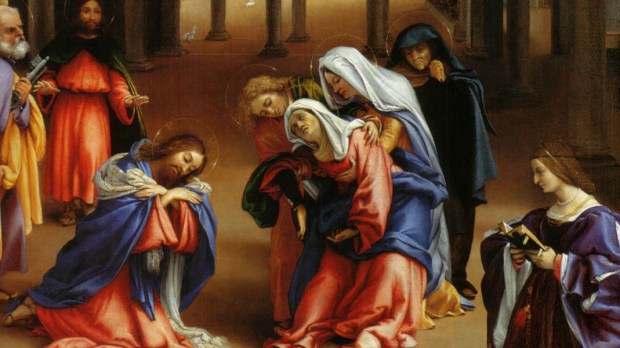The Passion Narrative of Christ has dominated the world of painting, sculpture, music, theatre and other forms of art for ages. From Giotto to Rembrandt, every artist imagined and represented the betrayal, flagellation, humiliation, affliction and the brutal execution of Jesus in a unique way. Through their painful emotions they evoked the faithful to identify with Christ in His suffering and thus share in His salvation. Let us then journey with Jesus through His passion through 12 paintings during this season of Lent.
The first in this series is a heart-wrenching farewell between Christ and His Mother. This event is brought to life by Lorenzo Lotto, an Italian painter, in the year 1521. It marks the beginning of the climax of Christ’s mission, i.e. His Passion, death and resurrection. This episode is not accounted for in the Gospel but rather it is narrated at length in the Meditation of the Life of Christ by Pseudo Bonaventure.
In this “Christ taking leave of his Mother,” the sun is low on the horizon and dusk has settled over the land. After His supper at Bethany in the house of Martha and Mary, Christ visits His Mother in order to announce that His time had come. He kneels before her in filial obedience and with solemn sadness says “‘Most Beloved Mother… the time of redemption is coming. Now all things said of me will be fulfilled and they will do to me what they wish.’” (Chap 72 of the Meditations of the Life of Christ).
The anguish of the atmosphere is heightened by the impact of Christ’s words. As the Virgin swoons into semi-consciousness, her frail demeanor is supported by the distressed apostle John and Mary Magdalene. The older woman behind them joins her hands in prayer as her eyes of concern caress the afflicted mother.
Beholding this sorrowful scene are the other two apostles: Peter (as identified by the key) and Judas, the traitor. Although the Meditations makes no mention of either, both Peter and Judas find their presence in popular Italian Passion plays. It is to these apostles (the rock and the treasurer) that Mary entrusts her son and it is from them that she receives the most zealous assurances of fidelity to Christ; a fidelity that is broken and a trust that is lost. Their role displayed in the Passion plays and paintings enhances the tragedy and the gravity of the scene at hand.
The scene is set within a spacious and harmoniously proportioned medieval hall. The architecture is classical and the space ventilated. Roofed by a barrel vault, soft light pours into the inner field through the hushed porticoes and the colonnades. The melancholy of the hour pervades the air. It is the last meeting between a mother and her son.
The room is suffused by Mariological symbols. Mary, the central protagonist is placed below a luminous oculus. Representing the moon, it symbolises her Immaculate Conception. The background, in the form of the three arches, not only signifies the Trinity but also hearkens back to the scene of the Annunciation.
The pergola of the garden behind the porch recalls the hortus conclusus (literally an enclosed garden). This iconographical framework is derived from the verses of the Song of Solomon, chapter 4, verse 12: “The garden locked is my sister, my bride, a garden locked, a fountain sealed.” Also related to the Annunciation is the bridal bed at the far end and the desk with the open book at the far right.
As Mary recalls the announcement made by the Archangel Gabriel 33 years before, the pangs that were spared at Bethlehem seem to grow stronger now. As her son kneels before her in the same posture as the Archangel Gabriel had done in her youth, the same question troubles her heart, “How can this be?” And yet once again in solemn obedience she surrenders her will to God.
Her unconditional yes is allegorically depicted through the branch of cherries (paradise) and the orange fruit (purity, chastity and obedience) partially visible in the lowest sections of the painting. When understood separately the cherry branch placed below Christ stands for everlasting life while the orange placed below Mary announces her virtuous qualities and her role as a partaker in the plan of Redemption.
“Christ taking leave of his Mother” was intended to hang in the household of Domenico Tassi, a reportedly pious man and the patron of Lotto’s art work. Tassi left his mark in this painting through the portrait of his wife Elizabetta Rota.
She kneels in the foreground to our right, her heart and mind captured in contemplation. The book she holds would probably be a prayer book that guides her to an intense meditation on Christ’s Passion. Scurrying around her is her little pet dog, spelling out her faithfulness. She does not imagine the scene but faithfully participates in it. She dwells and lives out the Passion, death and resurrection of Jesus. This Lent, through this painting, she invites us to do the same!
This article was published in partnership with Indian Catholic Matters.

